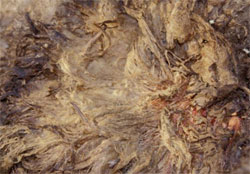Flystrike after floods
Download this page – Flystrike after floods ![]() [MS Word Document - 130.2 KB]
[MS Word Document - 130.2 KB]
Flystrike is a major disease and welfare issue for Australian sheep. It occurs in warm weather when the fleece of sheep is wet, such as from spring rains where there are dags present on sheep. It occurs less frequently in early autumn.
Heavy rainfall and floods during the warm summer months can increase the risk of flystrike. All breeds of sheep can be affected, mainly from body strike where fleece rot has occurred.
Other animals can be struck by blow flies where they have oozing sores – such as when they have been lying down for long periods – or in wounds.
Fleece rot during a wet summer and after flood
Fleece rot, Dermatophilosis and other forms of bacterial stain are very common during a wet summer and after flood.
Dermatophilosis on the lower limbs of sheep can attract flystrike about the feet or between the claws of the feet.

Preparing for flystrike after a flood
Sheep producers, owners and managers can take steps to reduce the likely impact before an imminent flooding event.
Identify high risk mobs
If time allows, apply a full body jet to all sheep in high risk mobs.
Treated sheep
Sheep that have had recent treatment are going to be more resistant to flystrike.
Examples of these treatments include:
- shearing – recently shorn sheep are quite resistant
- application of long-acting flystrike control chemicals
- crutching to remove dags will reduce the risk of breech strike.
Paddock selection
Blow flies prefer paddocks with shady trees and no wind. Use these paddocks for recently shorn sheep for protection from the possible cold snap that may accompany the flooding rains.
Further considerations include moving sheep to higher ground, where there will be access for inspection after the flood peaks.
Once the rain has subsided, move sheep to open, elevated paddocks. Wind exposure will dry fleeces quicker — and flies do not move far from trees in windy conditions.
Other preparations
Check:
- supplies of chemicals to treat individual sheep, and to also jet whole mobs later – source some supplies to have on hand
- jetting equipment
- equipment to treat struck sheep.
During flooding rains
Monitor recently shorn sheep 3 times a day for signs of cold stress, especially if cold and windy.
Sheep are being affected by the cold if they are starting to be ‘driven by the wind’, and action should be taken to provide more shelter.
Once they are huddled against fence lines the situation has become critical.
Check your general flood preparations:
- Are your livestock above the predicted flood level?
Detecting flystrike
Regular inspections of all sheep mobs and goat flocks are vital for signs of flystrike. Sheep must be inspected at least every 2 days if preventative chemical has not been applied.
Flooding rains may reduce the protective period of the chemical. Begin inspecting any mobs where treatment was applied some weeks ago.
For high risk mobs, follow these steps:
- Crutch, dag and pizzle ring susceptible sheep or mobs.
- Emergency shear to prevent or control body strike.
- Immediately treat any sheep seen with flystrike.
- Dispose of struck wool to reduce fly numbers (see solarisation).
- Control scouring by good nutritional and pasture management and appropriate worm control.
- Feed good quality hay when pastures are lush to bind faecal material.
- Ensure clean drinking water to reduce risk of scouring.
- Move susceptible stock to low risk paddocks if possible – such as higher ground that is likely to remain drier.
Using preventative chemicals
Use your chemical treatment for:
- at risk mobs
- weaners
- ewes about to lamb
- sheep who have had fleece rot or Dermatophilosis.
Withholding periods
Be aware of the potential conflicts caused by withholding periods:
- wool re-handling interval
- wool harvest interval (period before shearing)
- export slaughter interval
- meat withholding periods.
This is necessary to protect the health of you, your staff and our export markets.
Treating struck sheep
Look for sheep that are lagging behind the flock and, if standing at ease, show irritation to some part of their body, such as trying to nibble at a particular part of their body or feet. These are signs of flystrike.
These sheep must be caught and treated.
Follow these steps:
- Remove struck sheep from the mob. Leaving struck sheep in the mob attracts blowflies.
- The affected region should be clipped short of wool to expose all of the affected area, both the struck portion and where the exudate stain has run or spread.
- A clean margin of 2 to 3 centimetres about the area must be left – even more if long fleeces are likely to hang over the area when the sheep is standing.
- The clipped area must be dressed with a chemical (registered for the treatment of flystrike) – and reapplied at the intervals according to the manufacturer's directions on the label.
- The fleece removed from the struck area should be solarised. Do this by placing it into a black plastic bag and leaving in the sun. The heat generated inside the bag will kill the fly maggots, preventing future generations from attacking your flock.
Identify treated sheep using their EID or with other markers: This allows you to:
- comply with chemical withholding periods
- consider culling sheep that have been struck this year as part of your strategy to produce a more flystrike resistant flock.
More information
PARAboss provides up-to-date information on chemical use, fly biology, and has useful tools to model likely flystrike effects in you flock.